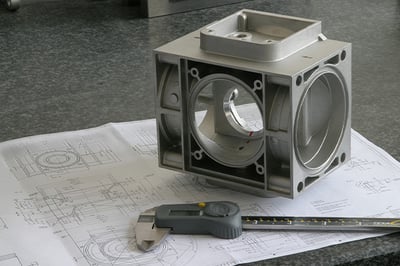Understanding the Process of Additive Manufacturing

Also known as 3D printing or even rapid prototyping, additive manufacturing is a decades-old process that has boomed in popularity in recent years. Machinery and hardware is now available to print large industrial metal components to small hobby setups, this process is becoming one of the most accessible processes for component manufacturing.
With the impressive range of materials additive manufacturing can print including thermoplastics, metals, ceramics and biochemicals; there are multiple methods for printing in each material. The seven methods are:
- Binder jetting
- Material jetting
- Powder bed fusion
- Material extrusion
- Vat photopolymerization
- Sheet lamination
- Directed energy deposition
Regarding the many options for 3D printing, they are four key steps that all the processes follow.
1 – CAD Design
Starting the process off is creating the artwork for the 3D model. Using CAD (computer aided design) software, the original design of the object will be created to real size dimensions. All whilst keeping in mind the structural factors of the design.
Factors to consider with the initial design include:
- Does it need to be lightweight?
- How much reinforcement is required for the function of the object?
- How will the object be printed? Will it need support structures when being printed or a base platform?
2 – Pre-Processing
In the process of finalising the artwork and files for printing, the designs are digitally tested in simulations to gather the structural integrity of the final model for when printed. More important for component printing especially, any early indication of flaws in the designs noticed at this stage would save resources as they only require adjusting the design.
Once approved, the files are made interoperable (readable across different software) to adapt the file for the hardware of the printer. As 3D printers need further instruction on how to print the design, the files need to be ‘spliced’. Slicing the design into layers to then calculate a tool path.
3 – Printing
The files now finalised, it’s time to print the product. How it is printed is determined by the technique as they all greatly differ. With the design being made up of layers of various materials, the adhesion between the layers is critical to obtaining the optimum strength of the design.
To set the layers for the following tier either a curing agent, heat application or laser beam is required.
To compare just a couple of methods, binder jetting alternates its layers between a layer of powdered material and binding liquid. While selective laser melting (a form of powder bed fusion) would layer metal powder, fusing it with a laser.
4 – Post Processing
As the models are now printed but unfinished, the final stage is the refine the surface of all excess materials. This can be done by build removal, part separation or debinding.
The importance of the step is usually for functional/aesthetic purposes, frequently also being the most time-consuming and expensive stage of production.
To smoothen out the surfaces for bulk batches of components, the best methods to achieve more surface area for a lesser amount of time require investments in finishing machinery such as shot blasters and vibratory finishers. Small-scale hobby printer would use equipment like sandpaper and rotatory tools smooth the surface of just one object
Summary
Overall, additive manufacturing is a very software reliant process. As well as the benefits to manufacturing production, the benefits of adopting digital tools to design, simulate and test components has encouraged the process to become very popular. By having complete control over how the object is printed, it has given individuals and companies more possibilities for component manufacturing.
To read our full series of articles about 3D printing & additive manufacturing, check out the links below.
Machines & equipment for sale
- Surface Treatment
- Cleaning & Degreasing
- Polishing & Belt Linishing
- Mass Finishing
- Ovens & Furnaces
- Process Cooling
- Shot Blasting
- Dust & Fume Extraction
- Air Compressors
- Rectifiers & Transformers
- Miscellaneous
- Latest Stock
- Special Offers
- Direct From Site Clearances
- Auctions
- Brand New Machines
- Available Immediately
- Sell Your Machine
Machine Alert
Get the latest machines emailed directly to you as they become available to buy online. Sign Up Now

